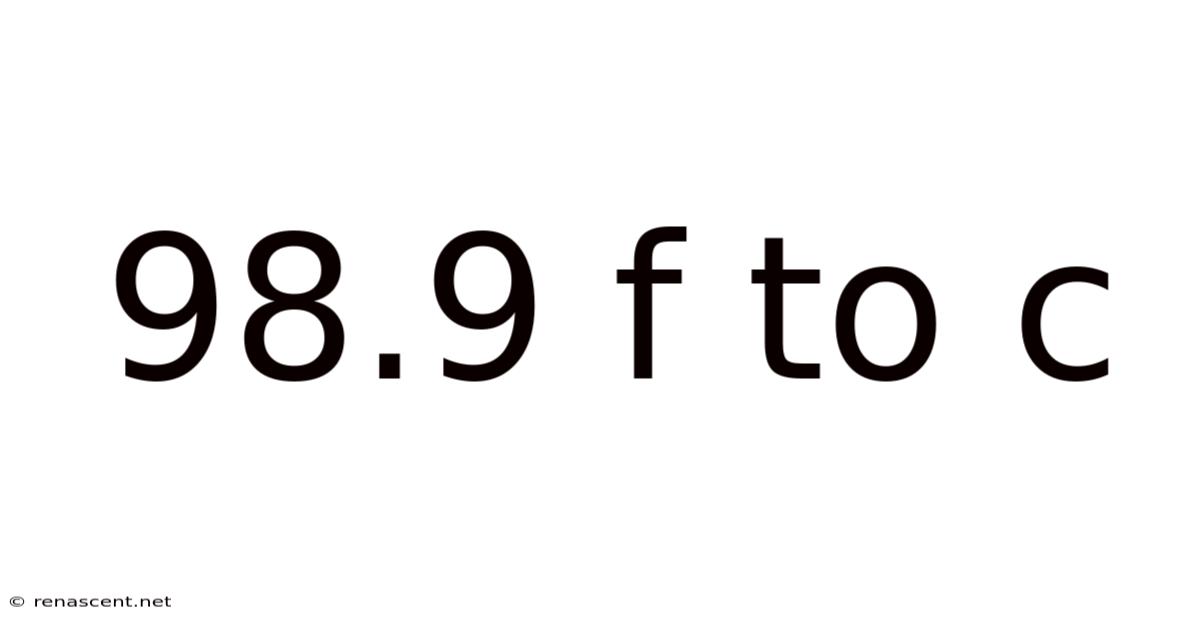98.9 F To C
renascent
Sep 13, 2025 · 5 min read

Table of Contents
Converting 98.9°F to Celsius: A Comprehensive Guide
Knowing how to convert Fahrenheit to Celsius is a crucial skill, particularly when dealing with temperatures related to health, cooking, or international weather reports. This article provides a comprehensive guide on how to convert 98.9°F to Celsius, explaining the process step-by-step, delving into the science behind the conversion, addressing frequently asked questions, and offering practical applications of this knowledge. Understanding temperature conversions empowers you to navigate a globalized world with ease and confidence.
Understanding Fahrenheit and Celsius Scales
Before we dive into the conversion, let's briefly understand the two temperature scales. The Fahrenheit scale, (°F), is primarily used in the United States, while the Celsius scale (°C), also known as the centigrade scale, is the standard in most of the world and is preferred in scientific contexts.
The key difference lies in the freezing and boiling points of water. Water freezes at 32°F and boils at 212°F in the Fahrenheit scale. In the Celsius scale, water freezes at 0°C and boils at 100°C. This difference in reference points is the basis for the conversion formula.
Step-by-Step Conversion of 98.9°F to °C
The formula for converting Fahrenheit to Celsius is:
°C = (°F - 32) × 5/9
Let's apply this formula to convert 98.9°F:
-
Subtract 32 from the Fahrenheit temperature: 98.9°F - 32°F = 66.9°F
-
Multiply the result by 5/9 (or 0.5556): 66.9°F × 5/9 = 37.1667°C
Therefore, 98.9°F is approximately 37.17°C.
This temperature is very close to the average human body temperature, typically considered to be around 37°C. A slight variation is normal and can be influenced by factors like time of day and individual metabolism.
The Science Behind the Conversion Formula
The conversion formula isn't arbitrary; it's derived from the relationship between the Fahrenheit and Celsius scales. The difference between the boiling and freezing points of water is 180°F (212°F - 32°F) in the Fahrenheit scale and 100°C in the Celsius scale. The ratio of these differences is 180/100, which simplifies to 9/5 or 5/9 when inverting the fraction for the conversion.
The subtraction of 32°F accounts for the difference in the freezing point of water between the two scales. Essentially, the formula proportionally scales the Fahrenheit temperature to the Celsius scale, adjusting for the different zero points.
Practical Applications of Fahrenheit to Celsius Conversion
Understanding temperature conversion is essential in various situations:
-
Healthcare: Converting body temperature readings between Fahrenheit and Celsius is crucial for accurate medical diagnosis and treatment. Understanding whether a fever is 100.4°F (38°C) or 99.1°F (37.28°C) makes a significant difference in medical assessment.
-
Cooking and Baking: Many international recipes use Celsius, requiring conversion for accurate results. Precise temperature control is vital in baking, as even a small deviation can significantly affect the outcome.
-
Weather Forecasting: Global weather reports often use Celsius, demanding conversion for those accustomed to Fahrenheit. Knowing the equivalent Celsius temperature allows for accurate comparison and planning.
-
Science and Engineering: Celsius is the standard in scientific and engineering fields, making conversion necessary when dealing with data or equipment specifications using Fahrenheit. Accurate temperature measurement is crucial in scientific experiments and engineering design.
-
International Travel: Navigating different countries with varying temperature scales requires proficiency in conversion. Understanding the local temperature helps in appropriate clothing choices and travel planning.
Frequently Asked Questions (FAQs)
Q1: Is there a quick way to estimate the conversion without a calculator?
A1: A rough estimate can be obtained by subtracting 30 from the Fahrenheit temperature and then dividing the result by 2. This method offers an approximation but might not be accurate for precise measurements. For example, for 98.9°F, this method gives (98.9 - 30)/2 ≈ 34.45°C, which is reasonably close to the precise conversion. However, for precise work, using the formula is recommended.
Q2: Why are there two different temperature scales?
A2: Different scales emerged historically. Fahrenheit was developed in the early 18th century, while Celsius was introduced later, offering a more intuitive and scientifically consistent scale based on the properties of water. While both scales measure temperature, they employ different reference points and scales.
Q3: Can I convert Celsius to Fahrenheit using the same formula?
A3: No, you need a different formula to convert Celsius to Fahrenheit. The reverse conversion formula is: °F = (°C × 9/5) + 32
Q4: Are there other temperature scales besides Fahrenheit and Celsius?
A4: Yes, there's the Kelvin scale (K), used extensively in scientific research. Kelvin is an absolute temperature scale, where 0 K represents absolute zero, the theoretical point at which all molecular motion ceases. It's related to Celsius by the formula: K = °C + 273.15
Conclusion
Converting 98.9°F to Celsius highlights the importance of understanding temperature conversions. This simple yet essential skill bridges the gap between different measurement systems, enabling effective communication and accurate interpretation of temperature data across various contexts. Whether it's monitoring body temperature, following a recipe, understanding weather forecasts, or working on scientific projects, this knowledge empowers you to navigate the world with enhanced precision and understanding. The step-by-step guide provided, combined with the underlying scientific explanation and FAQ section, equips you with the necessary tools for accurate and confident temperature conversions. Remember that while quick estimations are useful, the precise conversion formula remains crucial for accuracy in demanding applications.
Latest Posts
Latest Posts
-
55 C To Fahrenheit
Sep 14, 2025
-
Translate By The Vector
Sep 14, 2025
-
73 Inches To Feet
Sep 14, 2025
-
124 Lbs Into Kg
Sep 14, 2025
-
81 5 Kg To Lbs
Sep 14, 2025
Related Post
Thank you for visiting our website which covers about 98.9 F To C . We hope the information provided has been useful to you. Feel free to contact us if you have any questions or need further assistance. See you next time and don't miss to bookmark.